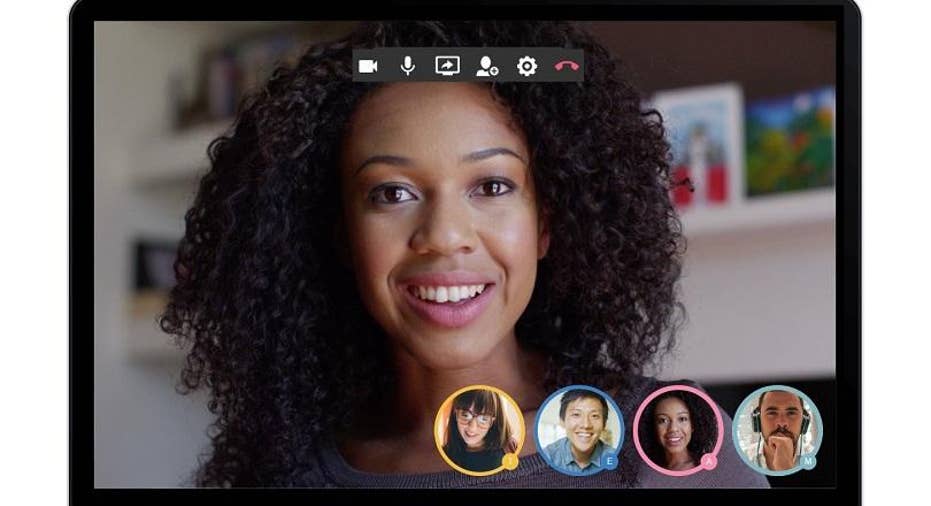Atlassian Launches Group Video Conferencing for HipChat

Businesses have endless options when it comes to online collaboration and conducting virtual meetings. Though, if your small to midsize business (SMB) or enterprise is already using products in the Atlassian ecosystem, such as Atlassian HipChat, Atlassian Confluence, or Jira Service Desk, the company just made built-in video chat a lot easier with the launch of an updated HipChat Video.
The new HipChat Video platform is designed for face-to-face virtual collaboration without the use of any integrations or third-party services outside the app, be it video conferencing software or a business voice-over-IP (VoIP) or private branch exchange (PBX) service. The product of Atlassian's 2015 acquisition of Blue Jimp and open-source video chat platform Jitsi, the updated HipChat Video is live today for HipChat Plus users at no extra cost. Users can join group video chats and share a document or browser window from within HipChat rooms with one click.
As far as functionality goes, HipChat Video works more similarly to consumer video chat apps such as Apple FaceTime, Google Hangouts, and the video calling features within Facebook Messenger. There's a floating toolbar with video, microphone, screen share, add a participant, settings, and end call options, and the other users on the call appear in multi-colored bubbles along the bottom of the screen.
The built-in client also doesn't use any kind of meeting URLs, PIN codes, and outside call-in lines, as does video conferencing software such as Cisco WebEx Meeting Center, Citrix GoToMeeting, and Join.Me. HipChat General Manager Steve Goldsmith said the redesigned video capabilities are geared toward removing the wasted minutes of coordination and call joining at the beginning of meetings.
"With today's update, we're making group video calling as simple as sharing a file in your team chat room. We're removing the friction of spinning up a new Hangout, downloading the right extensions to get on WebEx, or logging into an external service and hoping everyone remembers their passwords," said Goldsmith. "We're bringing video conferencing to where your team is already collaborating, not asking them to download plug-ins or move to another room."
Inside HipChat VideoAltogether, what redesigned HipChat Video resembles most is a hybrid video conferencing/VoIP service like Microsoft Skype for Business Online but built on WebRTC instead. Of all the ways collaboration is changing in 2016, WebRTC—the real-time in-browser communication protocol that's creating faster, more reliable native multimedia chat—is among the most prevalent. HipChat Video's underpinnings are founded in the WebRTC Jitsi Videobridge technology acquired in the Blue Jimp deal. HipChat already supports add-ons and integrations for other video chat services, including UberConference and Hangouts, which Google plans to transition into a completely business-facing app given the newly released Google Duo video chat app for consumers. Despite adding built-in video capabilities, Goldsmith said Atlassian will never pressure customers to work a specific way, and is committed to connecting external services through the Atlassian Marketplace and supporting integrations from more video providers through HipChat Connect.
"We're proudly agnostic when it comes to customizing Atlassian tools to suit your team's needs. We've built our products to be flexible and adaptive to the needs of teams rather than make teams adapt to us," said Goldsmith, who added that HipChat Video is uniquely suited for real-time collaboration within large enterprises.
"There are other services out there that help with exchanging information, but they lack context and any concept of persistence that sets team messaging apart from every other communication channel in the workplace," Goldsmith added. "HipChat is bringing easy group video to the team's natural environment—and that's what sets our group video and screen sharing service apart."
HipChat Video will be available to HipChat Plus users across other Atlassian applications as well. Goldsmith explained that the Jitsi team has worked to integrate HipChat Video as a back-end service for everyone from software developers using Jira and Bitbucket to Service Desk reps resolving tickets. The new built-in collaboration features are available as a free desktop app upgrade for HipChat Plus users, with an update for HipChat Server customers available in the near future.
Goldsmith said Atlassian's main goal with the platform is empowering ad hoc collaboration. On that front, he believes the updated HipChat Video is better suited than other video conferencing apps or VoIP services.
"Current video platforms kill the ideation process, making teams jump through hoops to work together. Collaboration is messy and doesn't conform to brainstorm agendas," said Goldsmith. "Just like mobile phones killed pay and home phones, video in team messaging platforms is killing VoIP and PBX."
"HipChat's new video and screen sharing addresses an unmet need that no video vendor provides—making ad-hoc group video calls as easy as ordering an Uber," added Goldsmith. "Every video vendor in the market requires a customer to leave their chat room to connect face-to-face. Distributed teams are not the future. Distributed teams are the present. In a world of distributed workforces, ad-hoc video collaboration accessible to everyone throughout an organization will be crucial to for teams to get things done."
This article originally appeared on PCMag.com.



















